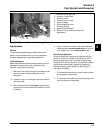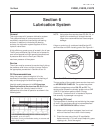
7.2
Section 7
Cooling System
Coolant Recommendations
Use equal parts of ethylene glycol (anti-freeze) and
water only. Distilled or deionized water is
recommended, especially in areas where the water
contains a high mineral content. Propylene glycol
based anti-freeze is not recommended.
This mixture will provide protection from -37º C
(-34º F) to 108º C (226º F). For protection and use
outside the indicated temperature limits, follow the
anti-freeze manufacturer's instructions on the
container, but do not exceed 70% anti-freeze.
DO NOT use anti-freeze with stop-leak additive(s), or
put any other additives in the cooling system.
Cooling System Maintenance and Service
Maintenance
Maintaining the correct coolant level and cleaning any
debris accumulation from the inlet screen and the
radiator surfaces, is critical to insuring long life, proper
system performance, and preventing overheating. To
ensure proper air circulation, make sure the grass
screen, radiators, cooling fins, and other external
surfaces of the engine are kept clean at all times.
Check the coolant level and clean away any debris
accumulation daily or before each use. At the same
time inspect the hoses and all system connections for
signs of leakage.
Servicing
Every 100 hours of operation (more often under
extremely dusty, dirty conditions), remove the upper
blower housing. Clean the air intake screen as
instructed in Section 4 and clean the external surfaces
of the engine. Clean the cooling fins of the radiator
with a soft brush or blow out using clean compressed
air. See Figure 7-2. To avoid damaging the cooling
fins, do not use a pressure washer. Make sure all
parts are reinstalled before starting.
Figure 7-3. Removing Upper Blower Housing and
Screen Assembly.
2. Check the coolant level in the overflow reservoir.
Coolant level should be between the ‘‘Max. Level’’
and ‘‘Min. Level’’ marks on the reservoir. See
Figure 7-4. Do not operate the engine with the
coolant level below the ‘‘Min. Level’’ mark. Add
coolant to the overflow reservoir as required.
Figure 7-2. Cleaning Radiator Cooling Fins.
Engine coolant should be changed every two years or
1000 hours, whichever comes first. When changing
the engine coolant, the system should also be flushed,
to remove any contaminants left behind during
draining. Following are recommended procedures for
checking, draining, flushing, and filling the cooling
system.
Checking Coolant Level
The coolant level should be checked at the overflow
reservoir, located under the upper blower housing
assembly.
1. Unhook the retaining straps and remove the
upper blower housing and screen assembly. See
Figure 7-3.


















